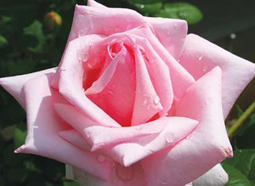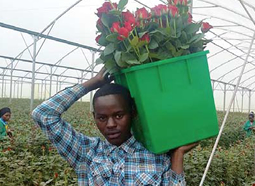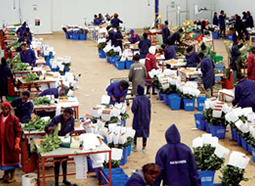 loriculture has emerged as a viable diversification option in the agri-business. It is a rapidly expanding dynamic industry recording a growth rate of more than 15 per cent per annum in the last two decades. Rapid urbanization, increased income levels and changes in social values resulted in increase of export market for cut flowers. Improvement in the general level of well being and increased affluence particularly among the middle class is also another reason for increase in the volume of local flower market.
loriculture has emerged as a viable diversification option in the agri-business. It is a rapidly expanding dynamic industry recording a growth rate of more than 15 per cent per annum in the last two decades. Rapid urbanization, increased income levels and changes in social values resulted in increase of export market for cut flowers. Improvement in the general level of well being and increased affluence particularly among the middle class is also another reason for increase in the volume of local flower market.
The post-harvest behaviour of flowers is an outcome of the physiological processes, occurring in leaves, stem, flower bud, leafless peduncle or scape connecting bud to the stem. Some of these processes may act independently to affect the senescence and vase life of cut flowers but most of them are inter-related. The nature and extent of postharvest damage is typical for each crop or cultivar. The post harvest losses become important especially when dealing with the export of fresh flowers to distant and foreign market. Therefore, patient, soft and expert handling of flowers is of utmost importance after harvest.
The post-harvest quality of flowers depends upon mainly three factors.
- Pre harvest factors
- Harvest factors
- Post harvest factors
Pre-Harvest Factors Genetic Or Inherent Makeup Postharvest lasting quality of flower species and cultivars vary considerably due to differences in their genetic make-up. Specialty flowers have a higher vase life compared to other flowers like rose, Growing Conditions Most cut flower crops require well-lighted conditions. On the contrary, too high light intensities cause scorching and dropping of leaves and abscission of petals. Flower crops are also specific in their temperature requirements. Optimum temperature and photoperiod, media qualities, etc differ from crop to crop. Flowers also require adequate nutrients for good longevity. High nitrogen doses should be avoided as they increase susceptibility to diseases. Flowers damaged by pathogens, insects and pests also show high ethylene production resulting in poor vase-life.
 Harvest Factors
Harvest Factors
The most important factors for harvest are when, how and where—“when” the plant material will reach the optimum stage of development and “when” during the day to harvest. Each plant material has its own best harvest stage and this can vary depending on the use of, and market for, the crop. Flowers for preserving usually are harvested more mature than those for fresh, wholesale markets. The best time is the coolest part of the day and when there is no surface water from dew or rain on the plants.
Right stage, method and time of harvesting of flowers are of considerable importance to ensure their long vase-life. The stems should be cut with sharp knives or secateurs.
The flowers of rose, carnation, gladiolus, tuberose, daffodils, lily, iris, freesia and tulip should be harvested at bud stage since their buds continue to open in water. Harvesting of flowers at bud stage is always preferred as their buds have long vase-life, are less sensitive to ethylene, easy to handle during storage and transport and are less prone to diseases and pests.
Post Harvest Factors
Environment
The environment (temperature, relative humidity and gaseous composition) of the place where the flowers are handled is also crucial in determining the ultimate keeping quality of the flowers. At higher temperature, opening of flower buds and rate of senescence hastens. Cool chain should be maintained through-out. Cool chain includes the temperature regulation at all stages right from pre-cooling to final shipment. At low temperature, rate of respiration; ethylene production; transpiration rate; and microorganism multiplication would be low/ minimum. Lower Humidity results in higher rate of transpiration. Exposure to air pollutants, ethylene from external sources (storage along with veg’s/fruits) adversely affects the postharvest life and quality of fresh flowers.
Water Relations
The termination of life of the harvested flowers depends on water uptake and transport, water loss and the capacity of the flower tissue to retain its water. A water deficit and wilting develop, when the transpiration exceeds absorption of water. The rate of water uptake of cut flowers depends on transpiration pull, temperature and composition of solutes.
Disruption of water columns in stem vessels by air embolism and resistance to water flow in stems, also develop water deficit. Acidification of water and addition of wetting agent and flower food in the holding solution markedly improve water uptake of cut flowers.
Respiration: The rate of respiration depends on quantity of carbohydrates available in the harvested flowers, temperature and the use of certain chemicals to regulate it. With higher temperature, there is faster rate of respiration and burning of the tissue. Consequently, the life of flowers is shortened.
 Transpiration: Higher humidity in the air, less is the transpiration rate and vice-versa. Increased transpiration rate results in water stress and wilting of the flowers. Water deficit develops and wilting occurs when the transpiration exceeds water uptake/ absorption.
Transpiration: Higher humidity in the air, less is the transpiration rate and vice-versa. Increased transpiration rate results in water stress and wilting of the flowers. Water deficit develops and wilting occurs when the transpiration exceeds water uptake/ absorption.
Post-harvest deterioration is a result of depletion of carbohydrates due to increased respiration rate, decline in membrane stability index (MSI) due to microorganisms, water stress and increased accumulation of ethylene. To Improve water relations of cut flowers, re-cutting the stems in water, quick hydration (conditioning), maintenance of Cool Chain should be practiced.
Precooling And Storage
Precooling is a treatment given to flowers to remove the field heat immediately after harvest. This is done either by forced air cooling or hydro-cooling to bring down temperature from 200-300C to 10C in a relatively short period. Other methods are room cooling and vacuum cooling. Flowers can be stored for a longer period at low temperature. There are two methods of cold storage-wet and dry. Wet method is short-term storage, in which cut stems are dipped in water. Dry storage is more labour-intensive method and costly. The controlled atmosphere based on reduction of respiration rates, conservation of respirable substrates during, storage, and delay in ethylene-triggered changes cause senescence. It involves the use of increased level of CO2 and decreased levels of O2 in the atmosphere, low storage temperature and prevention of the build-up of endogenous ethylene. Optimum storage temperature varies with the flower, rose, carnation, chrysanthemum, should be stored at low temperatures (0 – 10oC).
Conditioning/ Hardening
Restores the turgor of flowers wilted after harvest, storage or transport. Conditioning can be done with de-mineralized water supplemented with germicides and acidified with citric acid. Some wetting agents can be used for this purpose. Loading of flowers with high concentration of silver nitrate or nickel chloride of cobalt chloride for a short period of time is known as impregnation. It is helpful in reducing the attack of microbes and synthesis of ethylene.
Pulsing
Treating the flowers with high concentration of sucrose and germicide for a short period of time, in order to improve the shelf life and to promote flower opening. Pulsing is beneficial especially for flowers destined for long storage period or long distance transportation. Bud Opening
Use of germicides, sucrose and hormonal solution to promote the opening of immature buds in crops like chrysanthemums, rose, carnation etc. Grading, Bunching And
Packaging
After harvesting the flowers should be graded according to various grades as per specification for local and distant market. Then these should be pulsed and made into bunches. Cut flower should be packed in corrugated cardboard boxed or sleeves. Packaging must ensure protection of flowers against physical damage. Cold Storage
After pre-cooling and pulsing the flowers can be stored at low temperature. Controlled atmospheric (CA) modified atmospheric (MA) or hypobaric (LP) storage method can be used to enhance the postharvest life of flower.
Packing And Transporting
Packaging ensures fresh flowers to the consumers. Lower rate of transpiration, respiration and cell division during transportation, are essential for long storage life and keeping quality. Before packing, flowers should be dried. Packing must ensure protection of flowers against physical damage, water loss and external conditions detrimental to transported flowers. Boxes made of corrugated fibre boards are good. Flowers sensitive to geotropic bending must be transported in an upright position. The flowers should be transported at an optimal low temperature. The relative humidity of the air during precooling and shipment of cut flowers should be maintained at the level of 95-98%. Lack of light during prolonged transportation particularly at high temperature causes yellowing of leaves in many flowers.
Shipment of flowers is usually done by truck, air and sea. For short distance and time period, cut flowers may be transported in insulated trucks without refrigeration after precooling and proper packing. Flower should be transported in corrugated cardboard boxes. The flowers which are sensitive to ethylene, ethylene scrubbers containing KMnO4 should be added to those boxes. Some of the flowers are sensitive to geotropic bending, so these should be transported in upright position. Some of the flower crops show yellowing during transportation due to lack of light, therefore there should be a provision of light inside the transporting vehicle.
Holding Solutions
After pulsing and storage, flowers are held in a solution containing sucrose, germicide ethylene inhibitor and growth regulator. It’s basically aimed at providing nourishment to the cut flowers. The flowers can be kept in holding solution either at wholesaler, retailer or consumer level.
 Use Of Preservatives/Post-Harvest Chemical Treatments
Use Of Preservatives/Post-Harvest Chemical Treatments
Preservatives in the form of tablets or powder are prepared from a mixture of chemicals-sugars, germicides, salts and growth regulators. Various types of conditioners are sugar and biocide, antiethylene compound, and hydrated compound. An ideal preservative solution consists of sucrose (respiratory substrate for providing nourishment), biocide/ germicide (aimed to kill the microorganisms including bacteria), acidifier (to bringdown the pH of the solution & to increase the uptake), anti-ethylene compounds (to minimize the damage from ethylene), etc. Optionally, growth regulators, mineral ions (which facilitates solution uptake), could be added in the solutions. Cytokinins delay senescence of some cut flowers. Depending upon the concentrations, GA in some cases promotes longevity of flowers, while this is also used in bud opening solution. The IAA promotes ethylene production of isolated carnation petals. Commercially ready to use preservatives are available. The flowers like gladiolus, carnation, chrysanthemum and freesia benefit most by the pretreatment. Antiethylene compounds in preservative solutions reduce the action of ambient ethylene as well as autocatalytic production of ethylene by fresh cut flowers. Greatest improvement in cut flower quality and longevity is obtained when DICA or DDMH were combined with sucrose.
Preservatives can be effectively used in various solutions used in different stages of post-harvest handling viz., pre-cooling (removal of field heat), conditioning (aimed at rehydration of the cut flowers), pulsing (loading of substrate), bud opening (opening of flower buds harvested in bud stage), holding/vase solutions (to hold flowers continuously till the termination of vase life).
Post-harvest chemical treatments with boric acid (2-5%) and packaging by keeping ice packs in alternate layers was found effective for loose flowers of jasmine and tuberose. Irrespective of the postharvest handling followed, ageing and senescence is a continuous process and is characterized by loss of carbohydrates, loss of proteins, loss of phospholipids, decline in membrane stability index (MSI), production of reactvie oxygen species (ROS), transcription of new mRNAs, and de novo synthesis of new proteins (wastage of limited resources). Molecular Breeding for inhibition of ethylene biosynthesis or genetic engineering at ethylene receptor level or by over expression of hormones like cytokinins would go a long way to significantly improve the keeping quality of flowers.


